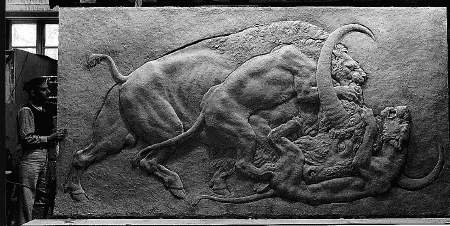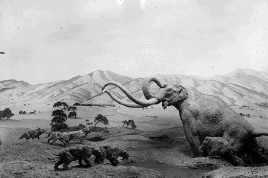
The images on our home page are sculptures created for the Golden Gate International Exposition that was held on Treasure Island in the San Francisco Bay in 1939 and 1940. They were sculpted by William Gordon Huff, an artist from Berkeley. Huff was born in 1903 in Fresno, California. He studied at the California School of Arts and Crafts in Oakland and at the California School of Fine Arts in San Francisco, as well as the New York Art Student's League and the Ecole Grande Chaumiere in Paris. Huff's most visible works at the Exposition were the four statues surrounding the central Tower of the Sun, representing Science, Agriculture, Industry, and Art. In addition to these and other monumental works of sculpture, Huff also created several sculptures and dioramas for the University of California Museum of Paleontology's exhibit at the Exposition.
The Exposition itself was held to commemorate the opening of Treasure Island, which was built in 1936 and 1937 to house San Francisco's airport, and the openings of the Golden Gate and Bay Bridges. The airport was to be the home of Pan American's China Clippers, which offered the first regular commercial flights from North America to Asia. These three achievements marked the full recovery of the Bay Area from the 1906 earthquake that destroyed most of San Francisco, and celebrated its desire to be one of the major industrial, trade, and cultural centers on the Pacific Rim. Thus, the theme of the Exposition was Pacific unity. Many of the nations bordering the Pacific offered exhibits, and the architecture and sculpture were designed to be a modern synthesis of Pacific art styles.

The large bas relief depicts two extinct American lions (Felis atrox) attacking a long-horned species of extinct bison (Bison latifrons). Both of these species are from the Pleistocene, or "ice ages" of California and their fossils are known from the La Brea tar pits of Southern California.

|

|

|

|

|
The small figures down the left of the home page, reproduced here, are some of the smaller sculptures from the paleontology exhibit at the Exposition. All of these animals are from the Pleistocene age. The figures at the top left and bottom right are dire wolves (Canis dirus), extinct relatives of wolves and dogs. At the bottom right is a sabre-toothed cat (Smilodon populator). In the center of the upper row is an extinct camel, and at the top right is a baby mammoth. The current whereabouts of these sculptures is unknown and it is likely that they were destroyed. The only other known surviving sculputure of Huff's from the Paleontological exhibit is a horned antelope head, currently housed in the Museum of Paleontology.
While we use these images of individual animals as icons on the UCMP Web server, it is important to realize that these figures were not intended to stand on their own, but instead were set in dioramas depicting the ecosystems of the past. One such diorama is shown below, showing a scene at the famous La Brea tar pits, about 40,000 years ago. You should recognize the dire wolves, one of the sabretooths, and the baby mammoth.

Click to view an enlarged copy of this photograph (CAUTION: over 200K)
Carpenter, P.F. and P. Totah 1989. The San Francisco Fair: Treasure Island 1939-1940. Scottwall Associates: San Francisco.
Neuhaus, E. 1939. The Art of Treasure Island: First-hand Impressions of the Architecture, Sculpture, Landscape Design, Color Effects, Mural Decorations, Illumination, and other Artistic Aspects of the Golden Gate International Exposition of 1939. University of California Press: Berkeley
Schnoebelen, A. 1991. TREASURES: Splendid Survivors of the Golden Gate International Exposition. GGIE Research Associates: Berkeley, CA.
Or visit the Museum of the City of San Francisco.
